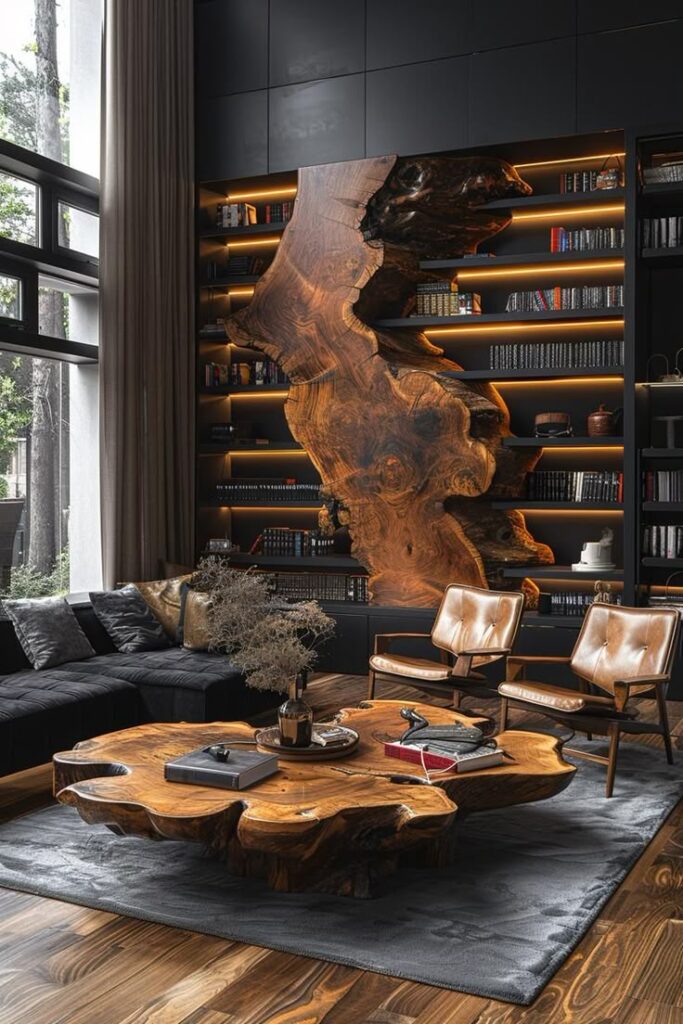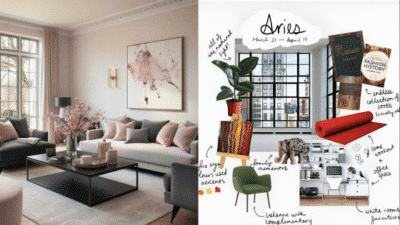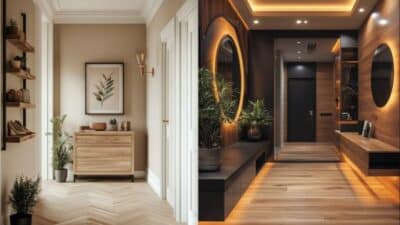Moody interior design gives your home a rich, dramatic atmosphere that instantly stands out from the ordinary. With deep colors, layered textures, and carefully chosen lighting, you can create spaces that feel both inviting and sophisticated. Moody interiors make a strong statement while offering a sense of comfort and individuality.
You don’t need a historic mansion or a brand new build to bring this style to life. The look is achievable in any home by blending bold color palettes, soft lighting, and unique, vintage-inspired elements. Whether you want a moody living room, bedroom, or dining area, there’s plenty of inspiration to help you shape the perfect ambience.



Key Takeaways
- Moody design transforms your space with depth and personality.
- Rich colors and textures create warmth and style.
- Personal touches and unique items add character.
What Is Moody Interior Design?
Moody interior design brings together dark hues, rich textures, and dramatic lighting to create spaces that feel both elegant and inviting. This design trend relies on deep color palettes and layered materials to achieve a stylish, sophisticated atmosphere.
Key Characteristics
A hallmark of moody interiors is the use of bold, dark colors like charcoal, navy, black, and forest green. These shades give you a sense of depth, comfort, and intimacy. Soft, low lighting—often from lamps, sconces, or candles—adds to the cozy, cocoon-like effect.
Moody interior design typically embraces a mix of textures. Velvet, leather, matte-finish paints, and rough woods are commonly combined for visual interest. Even in smaller rooms, these elements can make the space feel curated and thoughtful rather than simply dark.
Contrast is essential. Lighter accents, metallic details, and art or mirrors balance out the intensity of the deep color palette. This careful layering avoids a gloomy look and instead highlights different features throughout your room.
Popular Design Motifs
Common motifs in moody design include high-contrast wall art, oversized houseplants, and statement lighting. For furnishings, you might see tufted sofas, vintage rugs, or contemporary pieces in bold shapes. These choices help ground the space and encourage a sense of personal style.
Decorative accents often reflect a maximalist approach. Gallery walls, intricate mirrors, and sculptural objects frequently appear. Mixing eras—such as Victorian decor with modern lighting—adds character and avoids a one-note effect.
Color is used strategically. Deep jewel tones, warm metallics, and dark neutrals serve as a dramatic backdrop, while selective pops of brighter hues add vibrancy. This mix helps keep the room visually engaging and comfortable.
Origins and Influences
Moody interior design draws on several periods and movements. Victorian homes, known for their rich colors and ornate details, provide classic inspiration. The style also borrows from contemporary minimalism, resulting in a balance between boldness and refined restraint.
International influences appear through things like lush textiles, antique accessories, and dark woods seen in European and Asian interiors. Modern moody spaces might take cues from boutique hotels or artistic lofts.
This design trend has grown in popularity thanks to social media and a renewed interest in creating personal, atmospheric interiors. As a result, it’s a versatile style you can adapt to many different home types and architectural backgrounds.



Color Palettes for Moody Interiors
Embracing moody interior design means working with rich color palettes and intentional contrasts. Deep shades, tactile finishes, and select metallic details transform spaces into inviting, layered environments.
Foundational Moody Colors
To create a truly moody atmosphere, start with a foundation of colors that have depth and character. Common choices include dark navy, olive green, deep burgundy, and aubergine. These shades serve as your room’s main backdrop, setting a cozy, enveloping tone.
Pair foundational colors with muted neutrals like taupe, sand, or soft greige to prevent the room from feeling too heavy. You can also incorporate accent shades such as rusty orange, muted mustard, or stormy blue for visual interest.
Here’s a sample moody palette:
| Main Colors | Accent Colors | Neutral Tones |
|---|---|---|
| Charcoal Gray | Rust | Soft Taupe |
| Deep Green | Mustard | Warm Greige |
| Aubergine | Indigo Blue | Pale Beige |
Choosing three to five shades helps maintain balance while allowing for expressive styling.
Charcoal Gray and Charcoal Walls
Charcoal gray is a staple for moody interiors. This color works well on both small accent walls and throughout an entire room. Charcoal adds sophistication and drama, offering a slightly softer alternative to pure black.
When you use charcoal walls, consider their finish. Matte finishes diffuse light for a velvety effect, while satin or eggshell finishes highlight architectural details. Pair charcoal with wood tones, deep greens, or muted metallics to bring out its richness.
Charcoal also acts as a subtle neutral, grounding bold furnishings and lighter decor. If you’re unsure about painting an entire room, start with one wall or even custom shelving to see how the color changes the mood.
Color Drenching Techniques
Color drenching involves painting multiple surfaces—walls, ceilings, trim, and even built-in furniture—in the same deep tone. This approach envelops the room, creating a sense of intimacy and cohesion. It’s especially effective in smaller spaces such as powder rooms, bedrooms, or studies.
Choose a foundational color such as deep forest green, navy, or charcoal gray. Use the same color in varying finishes for different surfaces—for example, matte for walls, semi-gloss for trims. This adds subtle texture without breaking the harmony.
Color drenching also allows artwork, lighting, and textiles to pop, so consider contrasting textures and finishes for added interest. With thoughtful planning, this technique can turn an ordinary room into a statement space.
Incorporating Warm Brass Accents
Warm brass accents bring balance and elegance to moody interiors. Brass works well as a contrasting element against dark backdrops like charcoal or deep green. You can introduce brass through light fixtures, cabinet hardware, picture frames, or even mirrors.
Brass softens the overall palette, preventing dark rooms from feeling too intense or cold. It reflects ambient light, adding a touch of brightness without overpowering the design.
Try mixing polished and brushed brass finishes for subtle variety. Keep accents minimal but intentional, using them to draw attention to focal points such as a statement lamp or a set of drawer handles. Brass details can help tie together different elements within a moody color scheme.



Textures and Materials
Textures have a direct impact on the mood of your space. Choosing the right materials and combining them thoughtfully changes the way light interacts with a room, and can make your interior feel cozy, dramatic, or inviting.
Incorporating Rich Textures
Selecting rich textures—like velvet, leather, or boucle—adds instant depth and warmth. These tactile surfaces absorb and play with light for a visually impactful atmosphere.
Common materials for moody spaces:
- Velvet upholstery
- Natural wood furniture
- Matte black hardware
- Stone or marble accents
- Textured wall panels
Use these materials on larger surfaces (like sofas or curtains) and accent pieces. Don’t be afraid to include more rustic textures, such as unfinished wood or patinated metals, to maintain a sense of contrast and visual interest. Mix soft and hard textures to enhance the moody setting.
Layering Different Textures
Layering is key in moody design. Place multiple textures side by side or on top of each other for richness and comfort without overwhelming the senses.
Start with a base layer—think a matte-painted wall or a large area rug. Add another layer: a velvet sofa, a chunky knit throw, or a leather ottoman. Details like woven baskets, linen cushions, or a faux fur pillow bring more variety and tactile appeal.
Try to combine at least three different textures in one space. This variety makes the room feel curated rather than cluttered. Small touches, like ceramic planters or hammered metal trays, add subtle distinction.
Texture and Lighting Interaction
Lighting changes the way textures look and feel. Matte surfaces and rich textiles absorb more light, creating soft shadows and deeper colors.
Use accent lighting, such as table lamps, pendant lights, or wall sconces, to highlight textured walls or furniture. Directional lighting can bring out the detail in wood grain, velvet, or stone.
Position lights to graze over surfaces you want to emphasize. Dimmer switches help control intensity, letting you shift from dramatic night-time moods to softer, diffused daylight. The interplay of texture and lighting is a defining element in making moody interior design feel layered and engaging.



Vintage and Unique Elements
Authentic moody interiors use layered textures, rich history, and objects with character. Styling with vintage, antique, and odd artifacts helps you tell a personal story with your space.
Vintage-Inspired Aesthetic
A moody interior relies on deep, saturated color palettes and materials that look aged or storied. You might use dark velvet sofas, tufted leather chairs, or wallpaper with a faded botanical or damask pattern.
Lighting plays a crucial role—think brass table lamps, heavy chandeliers, or even vintage-inspired sconces. Accent with rich woods, distressed finishes, and old-fashioned hardware to set the tone.
Mixing eras is important, but keep cohesion by repeating colors or finishes. Vintage rugs, timeworn mirrors, and classic art prints ground a space and make it feel warm and intriguing.
Antiques and Vintage Elements
You can add depth by integrating actual antiques or retro pieces, such as an old writing desk, a carved armoire, or mid-century ceramics. These objects offer craftsmanship and a sense of nostalgia that can’t be matched by new items.
Visit flea markets, estate sales, or thrift stores to find genuine items with patina and history.
Integrate smaller decor, too, like antique clocks, vintage candle holders, or tarnished silver trays. Mixing different periods—Victorian portraits, art deco glass, or rustic farmhouse collectibles—creates an eclectic and personally meaningful atmosphere.
| Vintage Elements | Description |
|---|---|
| Ornate Mirrors | Add drama and reflect light |
| Brass Accents | Offer warmth and authenticity |
| Rugs | Anchor the mood and palette |
Gothic Oddities and Quirky Art
Unique finds like gothic oddities, scientific curiosities, or slightly eccentric pieces give your room personality. Display items such as old anatomical charts, shadow boxes with natural specimens, or vintage busts for a touch of drama.
Quirky art is important—a surreal painting, an unusual photograph, or a framed collection of retro postcards adds intrigue.
Arrange these elements on gallery walls, open shelving, or inside glass cabinets to make them focal points.
Combining the mysterious with the playful keeps the atmosphere sophisticated but never boring.
Designing Moody Spaces
Bringing a moody ambiance to your home relies on craftsmanship, clever décor, and contrasting elements. Each choice you make, from millwork to fabric prints, shapes the dark yet inviting personality of the space.
Built-In Bookcases and Bookshelf Ladders
Built-in bookcases create a sense of depth and groundedness, especially when painted in rich, deep tones like charcoal, navy, or forest green. These shelves become architectural features, drawing the eye and framing your collection of books, art, and curated decor.
A bookshelf ladder doesn’t just add function—it introduces an old-world, library feel that complements the moody theme. Choose dark woods or metals for the ladder to enhance drama and provide a practical touch.
You can display books with dark spines, vintage objects, and statement accessories for additional texture. Arrange items in small clusters and layer artwork along the shelves for visual interest. Proper lighting, such as wall sconces or gallery-style LEDs, prevents the space from becoming too dim.
Detailed Millwork and Molding
Detailed millwork and substantial moldings are a signature of moody interiors. Paneling, wainscoting, or decorative crown moldings add character and a sense of history, even to newer homes. Deep, matte finishes highlight these details and reinforce the cozy, enveloping aesthetic.
You might use box moldings in tall rooms to create grand, shadowed wall segments, or apply simple picture-frame molding for subtle sophistication in smaller spaces.
Pair millwork with high-contrast trim or coordinate with walls for a seamless look. Subtle variations in finish, such as eggshell on panels and satin on trim, add richness without relying on color alone.
Mix of Prints and Patterns
Moody interiors benefit from incorporating a mix of prints and patterns to counterbalance solid dark hues. Florals, geometrics, and vintage motifs work well, especially when rendered in muted or deep colorways.
Mixing patterns on upholstery, drapery, and throw pillows provides variety and keeps the space from feeling flat. Layering different textiles—like velvet, jacquard, and linen—also enhances the tactile experience.
Stick to a cohesive palette of 2-4 colors for harmony, but vary pattern scales for complexity. For example:
| Pattern Type | Best Use | Mood Impact |
|---|---|---|
| Florals | Pillows, wallpaper | Softens, romantic |
| Geometrics | Rugs, accent chairs | Modern, structured |
| Stripes | Curtains, throws | Elongates, dynamic |
Creating Moody Elegance with Personal Touches
Moody interior design is more than just dark paint and dim lighting—it’s about thoughtful details that make the space feel sophisticated and uniquely yours. By blending rich elements such as glam finishes, curated collections, and European-inspired touches, you can add depth and character to each room.
Adding a Touch of Glam
Incorporate metallics and luxe materials for a moody elegance that feels both refined and inviting. Think of velvet throw pillows in deep jewel tones, brass light fixtures, or mirrors with striking, blackened frames.
A simple way to start is by swapping standard hardware for brushed gold or matte black finishes. Statement lighting, like a chandelier with smoky crystals or a sleek floor lamp, also amplifies the atmosphere.
Create interest by layering textures—a high-gloss coffee table can sit beside matte ceramics or tactile textiles without clashing. Use accessories like candles in unique holders or glass decanters to add subtle shine. These glam touches work best when balanced, so avoid crowding surfaces.
Intellectual Pursuits and Home Bars
A moody room can reflect your intellectual interests by displaying books, art, or objects that inspire conversation. Fill shelves with vintage hardcovers, scientific curiosities, or framed prints against a deep, dramatic backdrop.
A home bar is a practical way to infuse personality. Use rich wood, marble, or dark-toned cabinets to set the scene. Stock your bar with classic glassware, and let a collection of spirits and bitters double as decor.
Arrange reading nooks near bookshelves or bars for a sense of retreat. Add a comfortable armchair, an adjustable reading lamp, and perhaps a set of dominoes or chessboard for added warmth. This setup encourages gathering and quiet moments alike.
Inspirations from European Estates
European estates often inspire moody interiors through their use of layered antiques, patterned textiles, and artful distressing. Reimagine this style by choosing dark-stained furniture or oil paintings with ornate frames.
Introduce rich tapestries, velvet drapes, or patterned rugs in subdued colors like burgundy, forest green, or navy. Architectural details—think picture moldings, paneled walls, or ceiling medallions—give rooms extra depth.
Bring in classic pieces: a bistro table in the kitchen, baroque mirrors in the hallway, or carved cabinets for storing collectibles. This style values history and craftsmanship, giving your interiors an “intellectual” depth while maintaining moody elegance.
- 37shares
- Facebook0
- Pinterest37
- Twitter0


